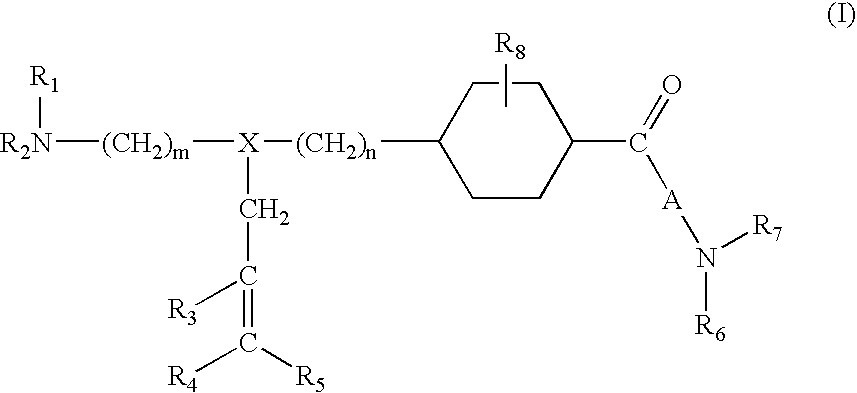1,4-Substituted cyclohexane derivatives
a technology of cyclohexane and derivatives, which is applied in the direction of antibacterial agents, drug compositions, immunological disorders, etc., can solve the problems of spinal cord injury deficits, permanent functional impairment, cell death, etc., and achieve the effect of blocking cell proliferation and cell proliferation
- Summary
- Abstract
- Description
- Claims
- Application Information
AI Technical Summary
Benefits of technology
Problems solved by technology
Method used
Image
Examples
example 2
Preparation of N-1(4'-tert-Butyldimethylsilyloxymethyl-cyclohexyl)methylid-ene]-1-phenylethanamine (4a)
[0452] A suspension of [4'-(tert-butyldimethylsilyloxy-methyl)cyclohexyl]m-ethanol (2, 5.20 g, 20.2 mmol) and Celite.TM. (10 g) in dry DCM (200 mL) was treated with pyridinium chlorochromate (8.60 g, 39.9 mmol), stirred at room temperature for 3 hours, and filtered on Celite.TM.. The filtrate was evaporated to a dark residue that was purified by column chromatography using 10% EtOAc in hexane as eluant to give 4.13 g (80%) of aldehyde 3 as a clear oil which was immediately used in the next step.
[0453] A solution of aldehyde 3 from above in dry DCM (50 mL / g) was treated with either (R)- or (S)-2-phenylethanamine (100 mol %) followed by magnesium sulfate (10 g / g of aldehyde), stirred overnight at room temperature and filtered. The filtrate was evaporated to dryness to give quantitatively the pure imine 4a as a low melting solid.
[0454] (R)-N-[(4'-tert-Butyldimethylsilyloxymethylcycloh...
example 3
Preparation of N-[4'-(tert-Butyldimethylsilyloxymethyl-cyclohexyl)methylid-ene] benzylamine (4b)
[0456] A solution of aldehyde 3 (1.62 g, 6.30 mmol) prepared as described above in dry DCM (100 mL) was treated with benzylamine (0.71 mL, 6.50 mmol) followed by magnesium sulfate (20 g), stirred overnight at room temperature and filtered. The filtrate was evaporated to dryness to give quantitatively the pure imine 4b as a low melting solid: m / z (FAB) 346.2 [(MH).sup.+]; .sup.1H NMR (CDCl.sub.3) showed a 82:18 ratio of isomers as measured by the isomeric signals at 7.65 and 7.79 ppm. Signals for the major isomer are as follows: .delta. 0.05 (s, 6H), 0.91 (s, 9H), 0.98 (m, 2H), 1.28 (m, 2H), 1.46 (m, 1H), 1.62 (m, 1H), 1.89 (m, 3H), 2.20 (m, 1H), 3.43 (d, 2H, J=6.25), 4.56 (s, 2H), 7.20-7.38 (m, 5H), 7.65 (d, 1H, J=5.07). Distinct signals for the minor isomer include: .delta. 4.61 (s, 2H), 7.79 (s, 1H).
example 4
Preparation of N-[4'-(tert-Butyldimethylsilyloxymethyl-cyclohexyl)methylid-ene]-1-amino-2-(methoxymethyl)pyrrolidine (4c)
[0457] A solution of aldehyde 3 prepared as described above in dry DCM (50 mL / g) was treated with either (R)- or (S)-1-amino-2-(methoxymethyl)pyrrol-idine (100 mol %) followed by magnesium sulfate (10 g / g of aldehyde), stirred overnight at room temperature and filtered. The filtrate was evaporated to dryness to give quantitatively the pure imine 4c as an oil.
[0458] (S)-N-[4'-(tert-Butyldimethylsilyloxymethylcyclohexyl)methylidene]--1-amino-2-(methoxymethyl)pyrrolidine [(S)-4c]: HRMS calcd for C.sub.20H.sub.40N.sub.2O.sub.2Si (M.sup.+): 368.2859, found: 368.2848; ).sup.+]; .sup.1H NMR (CDCl.sub.3) showed a 7:3 ratio of isomers as measured by the isomeric signals at 6.49 and 6.63 ppm. Signals for the major isomer are as follows: .delta. 0.01 (s, 6H), 0.87 (s, 9H), 0.90-1.95 (m, 13H), 2.08 (m, 1H), 1.68 (m, 1H), 3.27-3.45 (m, 8H), 3.55 (m, 1 H), 6.49 (d, 1 H, J=6.01)...
PUM
| Property | Measurement | Unit |
|---|---|---|
| time | aaaaa | aaaaa |
| enantiomeric excess | aaaaa | aaaaa |
| temperature | aaaaa | aaaaa |
Abstract
Description
Claims
Application Information
 Login to View More
Login to View More - R&D
- Intellectual Property
- Life Sciences
- Materials
- Tech Scout
- Unparalleled Data Quality
- Higher Quality Content
- 60% Fewer Hallucinations
Browse by: Latest US Patents, China's latest patents, Technical Efficacy Thesaurus, Application Domain, Technology Topic, Popular Technical Reports.
© 2025 PatSnap. All rights reserved.Legal|Privacy policy|Modern Slavery Act Transparency Statement|Sitemap|About US| Contact US: help@patsnap.com



